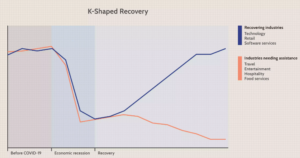In news : Economists are of the opinion that the prospects of a K-shaped recovery from COVID are increasing both in India and across the world.
What is K-Shaped Economic Recovery?
- A K-shaped recovery happens when different sections of an economy recover at starkly different rates.
- A K-shaped recovery is an unusual scenario where certain industries and individuals pull out of a recession, while others stagnate
- It essentially splits an economy in two, with the divisions occurring along class, racial, geographic, or industry lines
- It exposes pre-existing divisions and disparities in wealth, and can exacerbate them
- In other words, this type of recovery occurs when, following a recession, different parts of the economy recover at different rates, times, or magnitudes.
- This is in contrast to an even, uniform recovery across sectors, industries, or groups of people.
- It leads to changes in the structure of the economy or the broader society as economic outcomes and relations are fundamentally changed before and after the recession.
- This type of recovery is called K-shaped because the path of different parts of the economy when charted together may diverge, resembling the two arms of the Roman letter “K.”
The K-shaped recovery as a result of COVID-19
The COVID-19 pandemic has created a clear rift in the economy, so it makes sense that the K-shaped theory is gaining ground. There are multiple ways to characterize this divide – between those who lost work and those who didn’t, between “Main Street” and “Wall Street,” between those who work in industries that are still thriving and those who work in industries that are unable to operate.
How is it different from other forms of recovery?
Unlike other letter-shaped descriptors of economic recessions and recoveries (L-shaped, V-shaped, U-shaped, or W-shaped), which describe the path of economy-wide macroeconomic aggregate variables like Gross Domestic Product or total employment, a K-shaped recovery describes the path of different disaggregated economic variables, such as income across different segments of society or employment in different industries, relative to one another.

Drivers of K-shaped recovery
Several different economic phenomena may be at work in driving a K-shaped recovery.
- First, a K-shaped recovery can reflect creative destruction in an economy described by economist Josef Schumpeter, which is when new technologies and industries replace older technologies and industries over the course of a recession.
- Second, it can reflect the public policy response to a recession in terms of monetary and fiscal policy, which can benefit some segments of the economy more than others.
- Lastly, it can simply reflect the differential impact that the initial recession had on different parts of the economy in the first place, especially when the recession coincides with or is triggered by negative real economic shocks that impact specific parts of the economy and can have lasting effects on them more than others.
- Further, these three may not be mutually exclusive; all three may be at play in a given K-shaped recovery, along with other factors.
Other types of Economic recoveries
- U-Shaped Recovery:A U-Shaped Recovery is a type of economic recovery that experiences a gradual decline followed by a gradual rise back to its previous peak
- L shaped recovery:A type of economic recession and recovery that resembles an “L” shape in charting.
- V-shaped:A V-shaped recovery refers to a type of economic recession and recovery that resembles a “V” shape in charting.
















